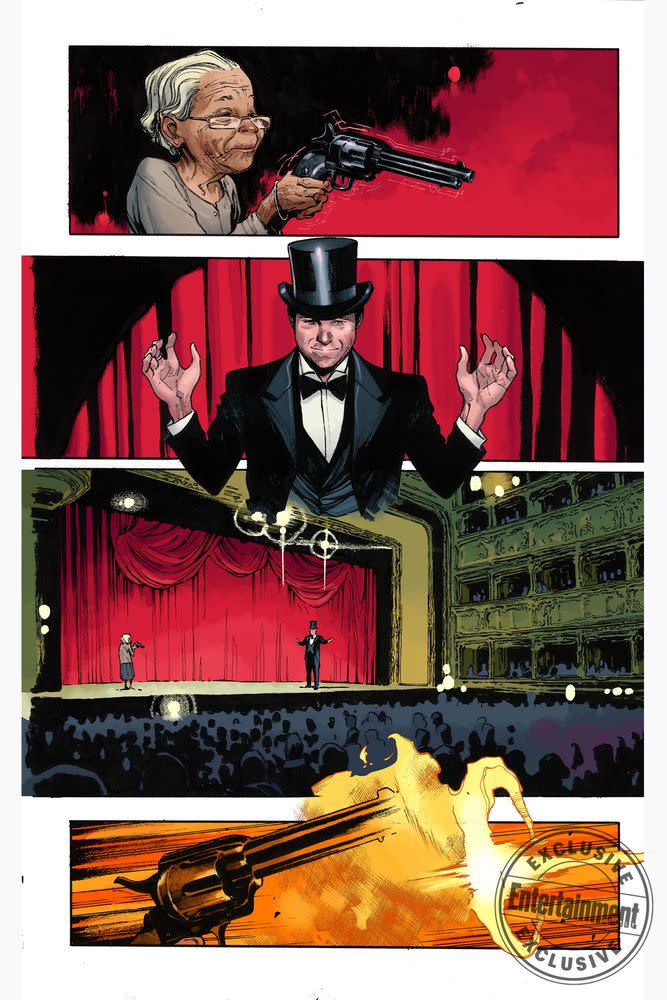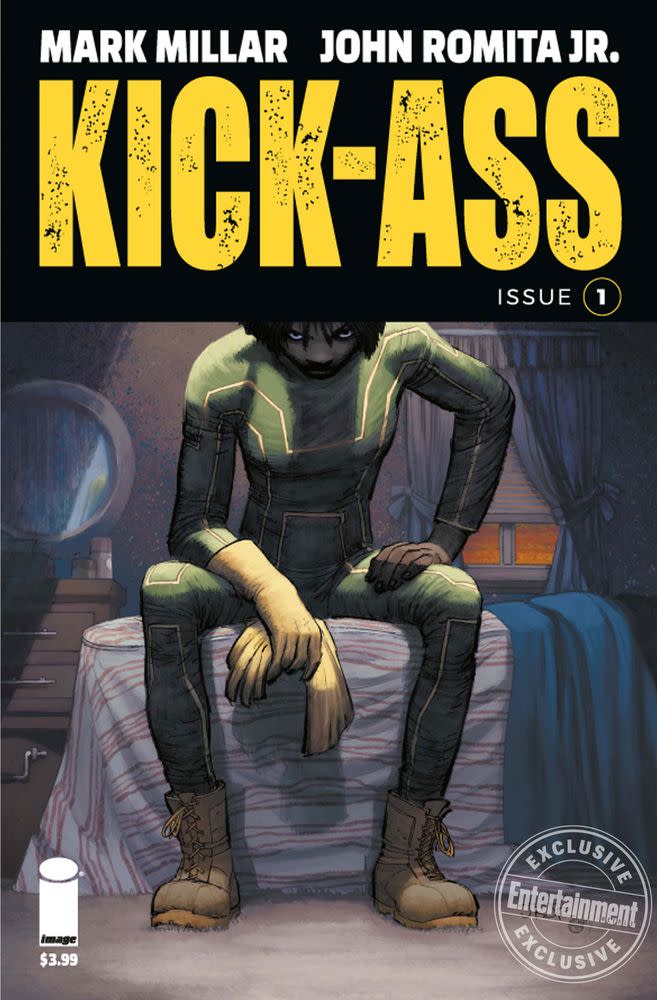Mark Millar on his new Netflix comic The Magic Order and the origins of the MCU
After several years away from American comic conventions, Mark Millar is making his return at this weekend’s Chicago Comic & Entertainment Expo (C2E2). On Friday afternoon, the creator Kick-Ass and Kingsman takes the main stage to preview his next comic, The Magic Order — his first series since selling his Millarworld line to Netflix. On Saturday, he’ll appear alongside Brian Michael Bendis, a similarly prolific and acclaimed comic writer who recently left his longtime home at Marvel for DC, to discuss their careers.
Ahead of C2E2, EW caught up with Millar to discuss The Magic Order. Given Millar’s wide-ranging career, the discussion also touched on his new Kick-Ass comic (complete with a new female African-American protagonist, Patience Lee), his role in paving the way for the Marvel Cinematic Universe, and the enduring magic of comic conventions. Check that out below, along with some exclusive first-look artwork from The Magic Order by artist Olivier Coipel.




ENTERTAINMENT WEEKLY: What can you tease about your Netflix partnership and what you’re working on there?
MARK MILLAR: First off, I think some people have been confused and think we’re licensing the stuff to Netflix. We sold the company outright to Netflix; they own Millarworld 100 percent. My wife and I have both been taken on as Netflix senior executives. We’re full-time members of staff. What I do now is I basically create movies and TV shows for Netflix internally. So I don’t create them as comics first, I just create them as stories within their system. I love doing comics, so part of my deal was as well as creating this new content and shepherding the old content over the next few years, I also want to do some comics on top of that, too. I’ll be doing about four graphic novels a year, which is about 20 issues, which is generally what I can do in an average year. Netflix never planned to get in the comics game, but they said, “If you’re gonna do these as comics, get the best artists in the world on them.” I was like, “Suits me, that’s great!” The very first one will be The Magic Order, and I got the greatest artist in the world drawing it, Olivier Coipel.
I’m not kidding, it’s the best artwork I’ve ever had. I’ve been in this job since I was 18, and it’s the best artwork on anything I’ve ever done. It’s incredible. Last week, my kids woke up on Monday morning, and I went on my computer, and I had like six pages from Coipel and a cover from Frank Quitely. I was like, this is just a dream. I can’t complain about Monday mornings when I get stuff like this.
Your comics almost always have very sharp and interesting premises. What is the premise of The Magic Order?
The easiest way to describe it might be to say The Sopranos meets Harry Potter, a magical fantasy-crime thing. As a kid, I always used to rationalize the fact that there were no monsters (since nobody’s ever seen a monster or caught one on camera), with the idea that there are people who take care of this, and that’s why you never see it. So the idea is there’s a family of wizards who have been around for thousands of years and they take care of bad stuff. They live among us as stage magicians and other eccentric jobs during the day, but at night, they get together and take care of problems. It’ll look like The Sopranos in that their underworld lives alongside the real one; they could be our next-door neighbor and then do something spectacular. They take care of supernatural problems.
What else are you working on for Netflix?
All these Netflix things we’re doing in the background. I started working for Netflix in this role in August of last year, and I’m now finishing my sixth project for them. It’s insane, and I’m absolutely loving it, I’ve never felt so reinvigorated. Studios had made moves on us before we sold to Netflix, but as soon as we walked in at Netflix, we knew these are our people. Walking into the studios felt like walking into the past, but walking into Netflix felt like walking into the future. What we’re doing is the 17 franchises they bought, plus these new ones like The Magic Order — we’re developing everything. That’s the beauty of Netflix. The studios have maybe 20 or 30 hours of TV coming out from Fox or Warner Bros or something, but Netflix has 1,000 hours of original material, and they have an infinite magical golden pot of money.

You’ve talked about the new Kick-Ass a lot. Now that the first few issues are on stands, how are you liking the reaction so far?
It’s great. Whenever you reboot something, whether it’s the new James Bond or the new Doctor Who, there were only 20 issues of Kick-Ass ever, but we got two movies and Pez dispensers and toys and all that, that character went down well. I hadn’t realized until the new one came out that this was kind of risky and might not go down super well. I’m so pleased we sold out that morning, and on Twitter, you even had Tessa Thompson saying she might want to play her. You think lightning can’t strike twice, but luckily it’s happened. I had a great time writing it last year, so I’m glad a lot of people can enjoy it now.
I remember you predicted on Twitter that Black Panther would become the highest-selling Marvel movie. Now it’s the highest-grossing superhero movie ever, and steadily climbing box-office rankings.
I’m really pleased about it because if there’s one thing I hate, as both a fan and creator, it’s the same old stuff. Like, I’m not really that interested in new Iron Man stuff, because I feel like all the good Iron Man ideas were probably in the first few appearances. New stuff breaking through is always exciting. I know it’s still Marvel, but at least they’re shaking it up a little bit. The idea of an African-American lead in a superhero movie, 10 years ago Marvel would never have done that. Same thing with a female lead. It’s preposterous it’s taking until 2019 for a female Marvel superhero. It lets you tell different kinds of stories, and just as a viewer, I’m interested in that.
Speaking of Marvel movies, in its early years the Marvel Cinematic Universe seemed to draw a lot of inspiration from the Ultimate Marvel comics you wrote. How does that feel, seeing that you helped kick Marvel onto its 21st-century path?
Zak Penn said to me years back when he was writing The Avengers script, “We’re translating The Ultimates.” I was like, “Really? Why that?” He made a very good point; he said it’s a very simple instruction for why you have an Asgardian god like Thor and a billionaire like Tony Stark and a World War II veteran like Captain America all in one room together. It’s a very clear, simple storyline that’s good for new readers, and it worked in cinemas as well. Kevin Feige has been very generous drawing on our stories for other Captain America movies, especially Civil War and all that stuff. When I was writing Old Man Logan and all these things, these were just stories I wanted to write. As a fan it was like, “Okay I’m getting to write the Avengers, this is awesome!” The goal of the Ultimate line was to make these characters accessible to people who’d never read a comic before. I never thought it’d end up as movies and never even considered I’d have a career in Hollywood as well. Then, weirdly, I started getting invited to meetings and seeing this stuff up walls in the studio itself, and you’re just like, hang on, this is quite cool. [The Ultimates artist] Bryan Hitch had brilliant designs. It was unexpected, but I loved it. As a fan, there’s nothing cooler than seeing your work in print… except seeing it become a movie.
At C2E2 you’ll be on stage with Brian Michael Bendis, who wrote for Marvel at the same time as you and has now left as well. What are you looking forward to about that?
Brian and I pretty much ran the Ultimate line ourselves. He did Spider-Man and Fantastic Four, I did X-Men and Ultimates. It’s funny to look back on now, but I had been begging them to relaunch the Avengers. Marvel had no interest in bringing the Avengers into the Ultimate line; they said those characters are dead and no studio was interested in them. I was always a really big Avengers fan. I got some credibility from doing Ultimate X-Men; that was the No. 1 book when it launched. So they said, would you want to do Ultimate Wolverine? I said no, no, I’d love to do Avengers. They won’t even let me call it the “Avengers” because they thought Avengers was such a dead franchise that I had to call it “Ultimates” instead. It’s crazy to think now that Avengers was such a diminished name in the industry, and Marvel had no faith in at all. But what was great was they let me do whatever I wanted because they expected nothing from it.
Brian and I talk all the time over email, but it’ll be great to see him in person again. It’ll be funny because we were both 29 or something when we started doing this, and now we have six or seven kids between us.
What are you looking forward to about returning to American comic conventions?
I love conventions. What’s crazy is you’re surrounded by thousands of people who are into the same thing you’re into. It’s like a secret brotherhood almost, the comics scene. You’ve got men and women from all across the globe who are all obsessed with the same things you’re obsessed with. There’s a fantastic energy. I’ve never gone to a convention and not had a good time. It’s nice going online; I love social media and interacting with readers that way, but to actually see everybody in one room and seeing everybody dressed up as characters and everything, it’s fantastic. If you think about it, writing is a solitary job. Go to meetings, but most of the time you’re sitting at a computer in a room on your own, or else you’re not doing your job. It’s actually lovely remembering these are the people actually reading this; it’s not just a deadline. The idea of someone waiting three hours to get an autograph is the ultimate compliment, or to see somebody walking up to you dressed as Kick-Ass.

